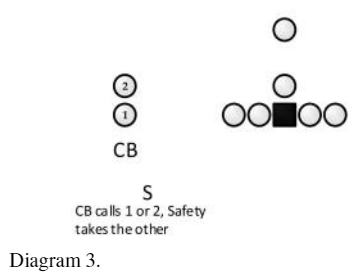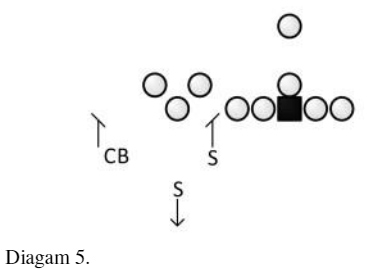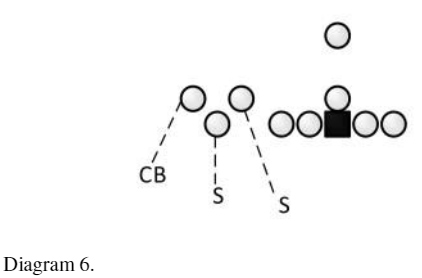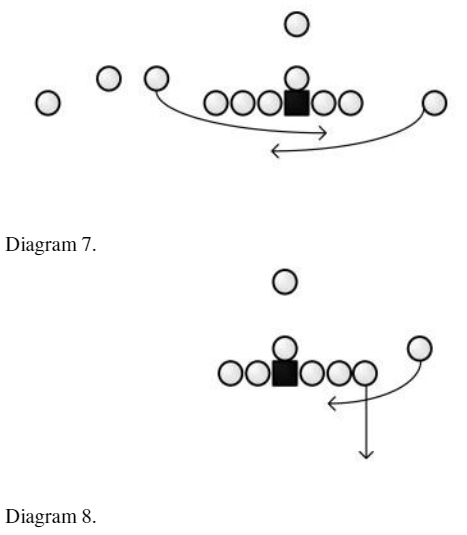| Effective Strategies for Dealing with Man - Coverage Beaters: Stacks, Bunches and Mesh |
| By: Adam P. Waugh - Co-Defensive Coordinator, University of Louisiana-Monroe
Provided by: American Football Monthly There a number of different things a defense can do to combat stacks, bunches, and mesh concepts: 1. Play the call with no adjustments. 2. Play the call with adjustments. 3. Check the call to a new coverage Playing the call with no adjustments is definitely the simplest strategy because it limits the amount of preparation and thinking for the players, but it is also the most dangerous because if it is not effective when the defense is in trouble because there are no other answers. If a team wishes to exclusively use this method, then it should do so because it has superior players, but even then, it will most likely experience problems. On the other hand, playing the call with adjustments is a compromise for teams that wish to continue using man coverage concepts, but are rational enough to understand that the offensive scheme is forcing the defense to change its way of doing things. When a team is unwilling to make adjustments, it demonstrates an arrogance or naiveté that can potentially lead to defensive disaster. However, building in special adjustments to a man coverage scheme requires significant meeting preparation and practice time to execute successfully. These adjustments can be difficult on players, and poorly executed adjustments are often just as bad as making no adjustments at all. Lastly, when a team identifies how the offense is trying to attack its man coverage, it can check the call to a new coverage that is better equipped to deal with the offensive strategy. Making a coverage check, especially from man to zone, can be effective because it can get the defense in the “right” call to stop a particular formation or play. However, this strategy still requires a great deal of preparation because the defense must be able to quickly and accurately identify what the offense is doing. Overall, each strategy has its advantages and disadvantages, and it is wise to avoid going “all in”on one strategy or another. Instead, the philosophy of the ULM defense is to use elements of all three strategies and continually change how the offensive scheme is defended. Players are given a menu of options that they can utilize vs. stacks, bunches, and mesh concepts and are taught to continually change things up by their choice or by game plan. This requires a significant amount of preparation by the players and coaches, but because the 3-3-5 scheme is heavily based in man coverage, the payoff is worth the investment. This philosophy of using elements of all the strategies allows the defense to regain the upper-hand by causing uncertainty for the offense because now the stacks, bunches, and mesh concepts can be defended in multiple ways, thus negating their effectiveness. STACKS
Offenses will often use WR stacks (Diagram 1) in an attempt to confuse and manipulate defenders into cutting one or more receivers loose in a route. There are three standard ways for handling WR stacks, and the first is to press the on-the-line receiver and play off-man on the other receiver (Diagram 2).This is one of the first answers that defenses will utilize vs. stacks. Doing this makes the man assignments very clear for the defenders and eliminates confusion especially when used sparingly, but also becomes very predictable for the offense.
For example, some teams may take a flex-TE and put him on the LOS to easily block the DB in press alignment. This enables the deep receiver to step back and catch a quick screen pass with up to a ten yard cushion from the defender that is covering him. So, while this strategy is straightforward, it can be manipulated by offensive personnel. An extension of this strategy entails having one defender align in a press position on the LOS who then has the choice to cover either receiver from the line of scrimmage (Diagram 3). Usually, the communication between the two defenders involved is done through hand signals before the play or by game plan. This is a smart way for defenses to slow down offenses because there is some pre-snap hesitancy about who is covering whom. This is especially good vs. quick screens because it can greatly reduce the amount of space in which each defender has to make an open-field tackle. This technique does take time to master, though, because it can be difficult for the on-the-line defender to cover the stacked receiver based on his release and route.
Lastly, the two defenders can employ an in/out strategy vs. the stack. In an In/Out, both defenders align off and at the same level with tight leverage to both shoulders of the stack. As the route develops, the inside defender is responsible for the first inside or second outside route and the outside defender takes the first outside route or second inside route. In theory, this is relatively simple for basic routes, but if used too often it can easily be manipulated by offensive schemes. For example, an In/Out is especially susceptible to double in-breaking or out-breaking routes because one of the defenders will invariably end up in a chase position (Diagram 4). However, they can be helpful vs. the run game as opposed to pressing because both defenders now have the opportunity to beat blocks in the open field in pursuit of the ball. A critical coaching point for an In/Out is that both defenders must align at the same depth, open up their vision to see both receivers, and not be afraid to give ground to maintain an ample cushion. It should also be noted that snag (in and out) routes can be difficult. In this case, defenders should be instructed to jump the in or out cut as soon as it declares, and once the route declares, then the defender should “lock on” and stay with the receiver regardless of subsequent breaks.
Bunches Bunches have proved especially effective at disrupting man coverage schemes because they can be employed in a variety of ways – close to the box or split out wide and also as a means to pass or run the ball. A basic three-man bunch can be defended in a variety of ways. The first is to 3-Way the bunch (Diagram 5). This is very similar to the in/out method, but uses three defenders instead of two. In this scenario, three defenders (DBs and/or LBs) basically “zone off” the bunch where one defender takes the first outside route, one defender takes the first inside route, and another defender takes the deepest, middle route. Just like in an In/Out, a 3-Way requires defenders to play with substantial cushion, with the middle defender slightly deeper than the outside and inside defenders. Vision must be widened even more, this time to include three receivers. Depth is a defender’s friend in a 3-Way because it is very easy to get visually tricked by crisscrossing routes off the LOS. For that reason, defenders are taught to give ground and let the bunch “sort itself out."
As an alternative to the 3-Way, the defense can “press the point” and use an In/Out for the off-the-line receivers. Essentially, this allows a strong press defender to eliminate one receiver while allowing the other two defenders to bracket the remaining receivers to avoid picks. This is a good change-up to a 3-Way because it can wreak havoc on offensive routes designed to beat 3-Ways. In addition, through film study, defenses can also determine a particular player to press and take out of the mix even if he is off the LOS. This is especially effective because it reduces the certainty of the offense in how to attack with its bunch formations. A potential issue with pressing the point is traffic control where the press defender can easily be picked or rubbed off the LOS by another receiver resulting in an open receiver. Another lesser-used strategy is to “lock it up” where the defenders play straight man-to-man defense with no adjustments. This can be effective vs. bunches that have a little more spacing than normal tight bunches. One coaching point with this strategy is to have great man eyes because any lost vision will result in open receivers, but the most critical point is that all three defenders must absolutely align at different levels (Diagram 6) in order to avoid picking each other off when chasing crossing routes. The “lock it up” strategy can be successful when the defenders are superior players or the offensive route structure is fairly basic and predictable. It should also be noted that this method should only involve a LB if there is a favorable matchup with a RB or TE as one of the receivers in the bunch.
The last tactic for dealing with bunch formations is to scrap the man coverage and have the entire defense go to a zone check. This offers some peace of mind for the defense because everyone will be on the same page and there is much less concern about getting picked or cutting a receiver loose. However, zone checks do not always solve the defense’s problems. For instance, the defense may decide to check to cover 2 to handle a smash concept out of a bunch. n this situation, the offense can get wise to this check and use routes that beat cover 2 or even run the ball to take advantage of a weak box. The point is that a single zone check will rarely, if ever, be the total answer because it will not be able to stop everything. In that case, should the defense have multiple zone checks to handle different types of bunches (e.g., 3 x 1 vs. 2 x 2, tight or wide)? Perhaps, but doing so will greatly increase the burden placed on the players to identify formations and make adjustments. Similar to making a zone check to an empty formation, offenses can easily take advantage of the check unless it changes periodically and is unpredictable. Therefore, a zone check should be used occasionally vs. bunches and not be the same coverage every time. Mesh Mesh concepts are where receivers cross at a shallow depth in an attempt to rub or pick defenders that are chasing the receivers in man coverage. Mesh concepts can come from opposite sides of a formation or from the same side ( Diagrams 7 and 8), and unlike stacks and bunches, do not always offer a pre-snap recognition of what is about to happen. For that reason, very few checks can be utilized to deal with mesh concepts; instead, players must be coached to recognize the clues and make pre-snap alerts to the defenders involved. Often, defending mesh concepts is a matter of game planning where mesh routes occur in specific down and distance situations, or out of certain formations. In addition, mesh concepts can also be indicated by tight splits of receivers that show the receiver’s intention to quickly get across the field .
Obviously, if a coach suspects that a mesh concept is coming, then it is wise to get into a zone coverage so that defenders can let the mesh take place with no threat of getting picked. Realistically, though, there are going to be times where a defense is in man coverage vs. mesh, and it must be adept at handling it. In dealing with mesh concepts vs. man coverage, there are two main strategies that a defense can use. The first includes utilizing an extra defender such as a free player. In this scenario, the free player can double team or bracket one of the receivers involved in the mesh and take over one of the crossing routes from depth, thereby avoiding the pick. In addition, the defender that has help can then cut his receiver loose on a mesh release and zone up with eyes inside to help on the crossing route coming across to him. Essentially, as long as there is one more defender than the number of receivers involved in the mesh, then this strategy can be effective as it is basically a zone adjustment out of man coverage. If no free help is involved vs. a mesh concept, then it is helpful for the defense to declare who is “under” and who is “over” as they cover the receivers. Because man coverage units often see mesh routes, the players are taught to think mesh anytime they see an immediate inside release by their man. If it is taught this way, then the defenders will be ready for mesh, and if the mesh never happens, the defender will not be adversely affected in his man coverage. As an example, cornerbacks can be taught to always get over the mesh, while safeties and linebackers can always be taught to stay under. Ultimately, it does not matter who does what as long as there is a plan in place and the players know how to react. Above all, it is important that defenders are aggressive and do not hesitate vs. mesh concepts. Often, mesh routes can be totally disrupted by a defender that gets his hands on a receiver and is able to re-route him off of his mesh path. These are some of the strategies that the ULM defense uses to deal with the various man coverage beaters that it has faced over the years. There are no easy answers to defending the various stacks, bunches, and mesh concepts that offenses can employ. However, the philosophy at ULM has always been to use a variety of strategies instead of relying on just one or two. There are obviously many more ways to defend offenses than mentioned in this article, but hopefully this can be a starting point for defenses that are facing these problems. About the Author: Adam Waugh just completed his first season as co-defensive coordinator at the University of Louisiana-Monroe and his sixth coaching safeties. He previously coached defensive backs at Cal Poly and for six seasons coached safeties at Army. Waugh started every game of his playing career at Illinois State, graduating in 2001. He played for UL-Monroe Head Coach Todd Berry at Illinois State and coached with him at Army. |













